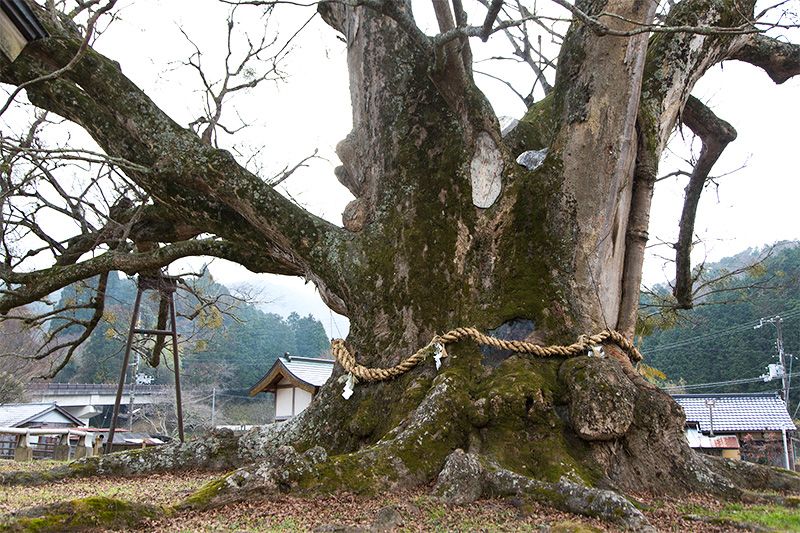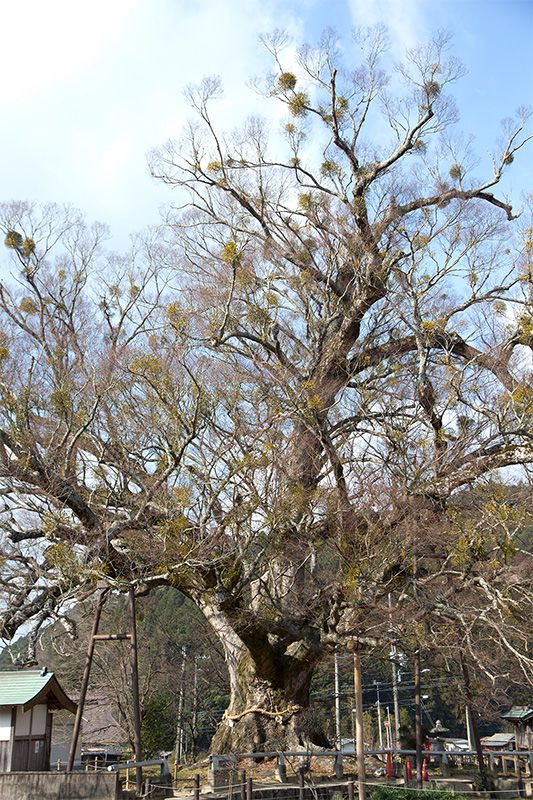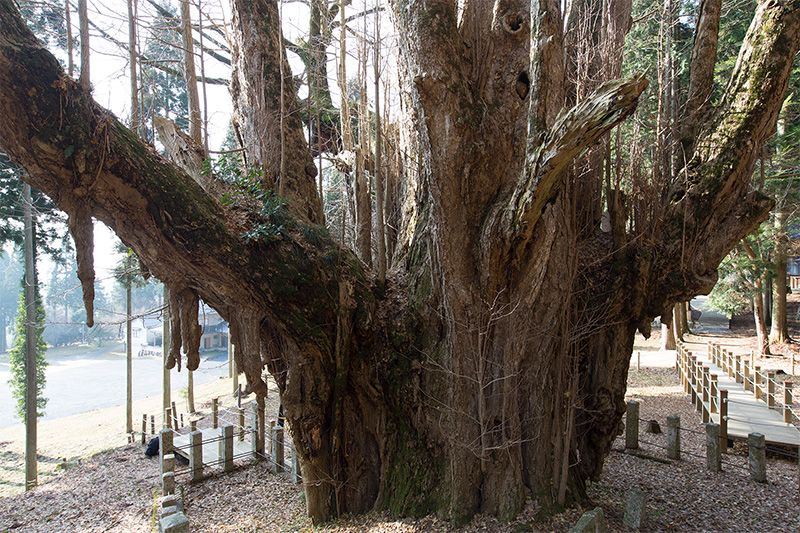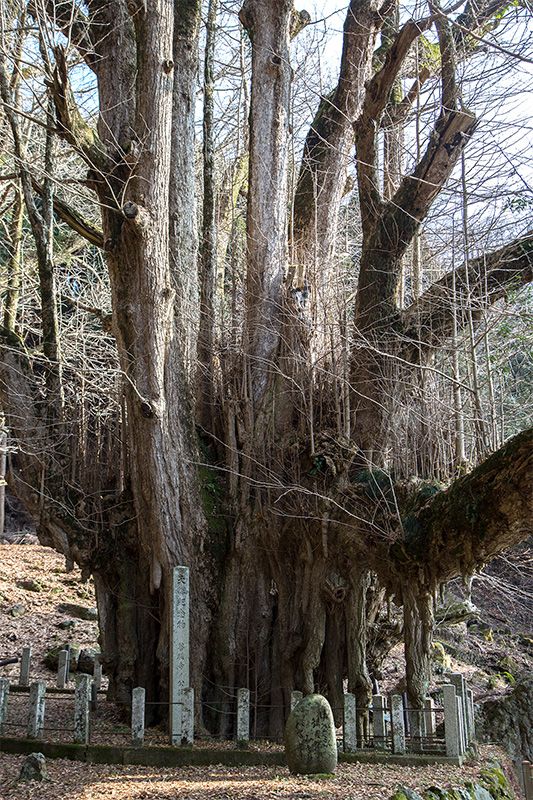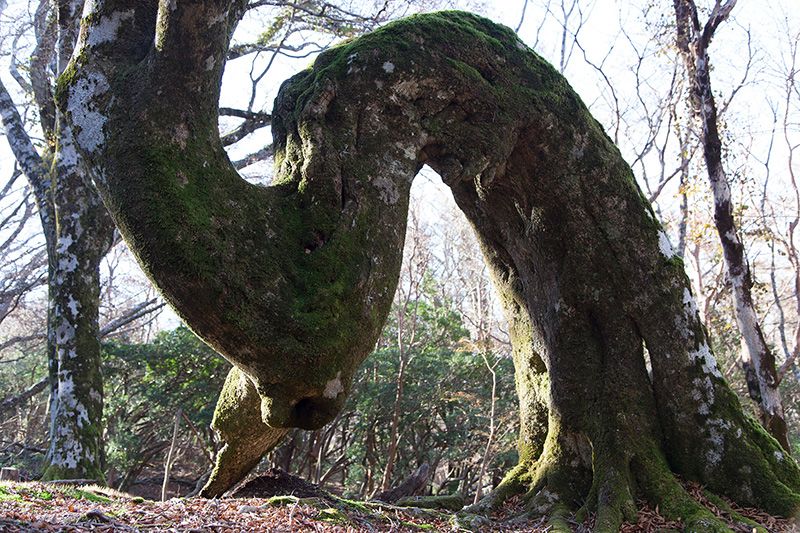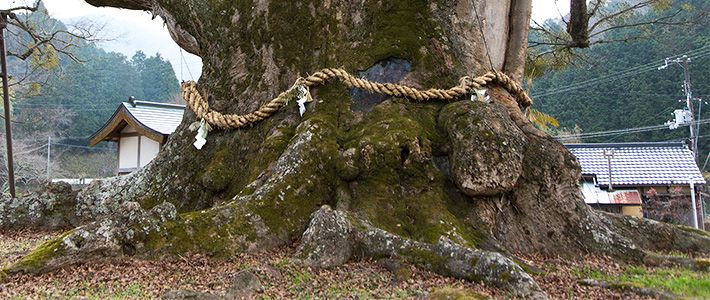
Japan’s Ancient Giants of the Forest
Slumbering Giants : Three Old-Growth Trees in Early Winter
Guideto Japan
Culture- English
- 日本語
- 简体字
- 繁體字
- Français
- Español
- العربية
- Русский
Humans since ancient times have found deep significance in the changing foliage of deciduous trees. We enjoy the blossoms and fresh green leaves of spring, the verdant, cooling canopy of summer, and the vibrant colors of autumn. Agricultural communities traditionally synchronized vital seasonal activities such as planting and harvesting with the annual cycle of trees, and relied on their bounty of fruits and nuts.
Early winter, when branches are bare, is also a special time. During this period kyoju, or old-growth trees, show their full, knotty forms, reminding us of the long, frigid season to come.
The Great Noma Keyaki (Osaka Prefecture)
Variety: Keyaki (zelkova) (Zelkova serrata)
Location: 266 Nomainaji, Nose, Toyono-gun, Osaka Prefecture, 563-0133
Trunk circumference: 14.15 m; height: 20 m; age: 1,000 years
Designated a national natural monument
Size: ★★★★★
Vigor: ★★★★
Shape: ★★★★
Crown spread: ★★★★
Grandeur: ★★★★
This giant keyaki, or zelkova, is one of the best known in Japan. Located within the confines of the Arinashinomiya Shrine in northern Osaka Prefecture, it has long been venerated by farmers who till the surrounding rice paddies. The shrine is dedicated to an agrarian god, and for generations people have seen the tree’s hearty spring foliage as portending a successful harvest.
Zelkova is a prodigious species, but they are comparatively less common in the Kansai region, where they were chopped down over the centuries to build the area’s numerous temples, shrines, and castles. In this regard, it is something of a miracle that the Noma keyaki has lived to such an impressive age. The tree is also unusual for being a single plant, its girth thought to be second only to a zelkova in Higashine, Yamagata Prefecture.
Older specimens of zelkova are prone to hollowing, and often all that remains of older trees are the outer layers of wood and bark. The Noma keyaki, however, has been spared this fate and stands robust and full. In fact, its vigor is such that workers once uncovered a root of the tree running through a construction site several hundred meters away.
Winter visitors will notice the tree retains a hint of green in its canopy even after it sheds its leaves. These verdant bundles are a specimen of mistletoe, known in Japanese as yadorigi. The parasitic plant draws water and nutrients from the ancient zelkova and must be cut back every few years to prevent it from inflicting permanent damage.
The tree also hosts more benign organisms. Over the last few springs various species of owl have built nests in the zelkova’s branches, attracting droves of tourists and bird lovers. My only hope is that the uptick in visitors will not affect the health of the tree or the peaceful surroundings.
The Grand Bodaiji Ginkgo (Okayama Prefecture)
Variety: Ichō (ginkgo) (Ginkgo biloba)
Location: 1532 Kōen, Nagi, Katsuta-gun, Okayama Prefecture, 708-1307
Trunk circumference: 11.9 m; height: 30 m; age: 900 years (estimated)
Designated a national natural monument
Size: ★★★★
Vigor: ★★★★★
Shape: ★★★★
Crown spread: ★★★★
Grandeur: ★★★★★
This burly kyoju towers in front of a stand of cedar trees inside the confines of the famed temple Bodaiji, located some 600 meters up Mount Nagi. Legendary priest Hōnen, the founder of Pure Land Buddhism, studied at Bodaiji as a boy and is credited with planting the giant ichō, or ginkgo, which is said to have sprouted from a staff he stuck in the ground.
Bodaiji for many years was without a head priest and the grounds had grown shabby from neglect. However, recent efforts have restored the confines, and a path now runs around the ichō to protect the tree’s roots.
The grand ginkgo boasts an impressive collection of aerial roots that hang down from its branches like wooden stalactites. Residents refer to these as rengi, the local word for a pestle. The abundance of these outgrowths attests to the vitality of the tree. During the Edo period (1603–1868) a heavy snowfall bowed a large branch to the ground, allowing the rengi to take root and eventually form a new trunk.
The top of the tree is more robust than the lower, giving it an unusual shape for such an old ichō. This imbalance is due to the central bole having withered and been replaced by new outgrowths. The abundant shoots are hidden during the summer month by the tree’s thick crown of leaves, but come winter visitors have an unobstructed view of the countless narrow branches that crisscross the ginkgo’s main limbs. Over the centuries these have combined into a surrogate trunk that now precariously supports the mass of the tree.
The best times to visit the Bodaiji ichō is during late fall when the temple lights up the golden foliage and early winter when its aerial roots are in full view.
The Snake Beech (Shizuoka Prefecture)
Variety: Buna (Japanese beech) (Fagus crenata)
Location: Jizōdō, Izu, Shizuioka Prefecture, 410-2515
Trunk circumference: 3 m; height: 15 m; age: 150 years
Size: ★★
Vigor: ★★★
Shape: ★★★★★
Crown spread: ★★
Grandeur: ★★★★
This uniquely shaped buna, or Japanese beech, is an oddity not only for its curved trunk, but for its location in the relatively warmer latitudes of the Izu Peninsula. As a species, Japanese beech prefer colder climates and are found in abundance in the Shirakami mountains that run through Akita and Aomori Prefectures in the north of Japan. Mount Amagi, however, provides a suitably cool, snowy environment for the trees and other cold-loving species.
The undulating buna was first discovered by hikers and stands off a side path about a kilometer from Mount Amagi’s Banzaburō summit. There are trail markers pointing the way that make it relatively easy to find. When I paid a visit a while back I found the tree basking in the winter sunshine.
The unusual s-shaped bole is likely the result of a long-ago catastrophe such as a lightning strike or windstorm that toppled the buna. Miraculously, though, the beech hung on by a thread—or more accurately its bark. While the core of the tree suffered irreparable damage, its skin sprouted fresh growth that eventually formed a new bole.
The accident is assumed to have happen around 100 years ago, and in the subsequent century the buna has grown robust enough to support its own girth. Coming through such a trauma, it has earned a deserved reputation among fans as a good luck tree.
(Originally published in Japanese on December 20, 2016. Photos and text by Takahashi Hiroshi.)